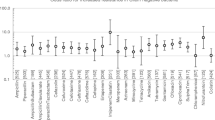Abstract
Using susceptibility rates of Pseudomonas aeruginosa, Escherichia coli, Klebsiella pneumoniae, and Enterobacter cloacae over time as markers, we assessed the significance of the change of susceptibility rates to imipenem, ceftriaxone, cefepime, piperacillin/tazobactam, and ciprofloxacin over time and the relationship to antibiotic use for the period 2000–2006. Antibiotic use–susceptibility relationships were assessed using longitudinal regression analysis. The variables “time” and define daily doses (DDD)/1,000 patient days for the specific drug related to the susceptibility rates of that particular model’s dependent variable were considered as the main effects, with significance determined at the 0.05 level. Decreases in susceptibility of the target organisms were common over the period of observation. Decreasing susceptibility trends over time were not statistically associated with the primary drug (e.g., organism susceptibility rate to imipenem with imipenem usage). However, secondary drug use was associated with susceptibility rates (e.g., susceptibility of E. cloacae to cefepime with piperacillin/tazobactam usage). These results suggest that antibiotic use–resistance relationships are influenced by the use of secondary antibiotics. Thus, a resistance problem may not be adequately addressed by simply altering the utilization of the primary antibiotic.
Similar content being viewed by others
References
National Nosocomial Infections Surveillance System (2004) National Nosocomial Infections Surveillance (NNIS) System Report, data summary from January 1992 through June 2004, issued October 2004. Am J Infect Control 32:470–485. doi:10.1016/j.ajic.2004.10.001
Neuhauser MM, Weinstein RA, Rydman R, Danziger LH, Karam G, Quinn JP (2003) Antibiotic resistance among gram-negative bacilli in US intensive care units: implications for fluoroquinolone use. JAMA 289:885–888. doi:10.1001/jama.289.7.885
Hidron AI, Edwards JR, Patel J, Horan TC, Sievert DM, Pollock DA, Fridkin SK (2008) Antimicrobial-resistant pathogens associated with healthcare-associated infections: annual summary of data reported to the National healthcare Safety Network at the Centers for Disease Control and Prevention, 2006–2007. Infect Control Hosp Epidemiol 29:996–1011. doi:10.1086/591861
Cosgrove SE, Carmeli Y (2003) The impact of antimicrobial resistance on health and economic outcomes. Clin Infect Dis 36:1433–1437. doi:10.1086/375081
Zervos MJ, Hershberger E, Nicolau DP, Ritchie DJ, Blackner LK, Coyle EA, Donnelly AJ, Eckel SF, Eng RHK, Hiltz A, Kuyumjian AG, Krebs W, McDaniel A, Hogan P, Lubowski TJ (2003) Relationship between fluoroquinolone use and changes in susceptibility to fluoroquinolones of selected pathogens in 10 United States Teaching Hospitals, 1991–2000. Clin Infect Dis 37:1643–1648. doi:10.1086/379709
Mutnick AH, Rhomberg PR, Sader HS, Jones RN (2004) Antimicrobial usage and resistance trend relationships from the MYSTIC Programme in North America (1999–2001). J Antimicrob Chemother 53:290–296. doi:10.1093/jac/dkh039
Bhavnani SM, Callen WA, Forrest A, Gilliland KK, Collins DA, Paladino JA, Schentag JJ (2003) Effect of fluoroquinolone expenditures on susceptibility of Pseudomonas aeruginosa to ciprofloxacin in U.S. hospitals. Am J Health Syst Pharm 60:1962–1970
Clinical and Laboratory Standards Institute (CLSI) (2009) Analysis and presentation of cumulative antimicrobial susceptibility test data; Approved Guideline—Third Edition. CLSI document M39–A3 (ISBN 1-56238-692-1). CLSI, 940 West Valley Road, Suite 1400, Wayne, Pennsylvania 19087–1898 USA
Durbin J, Watson GS (1951) Testing for serial correlation in least-squares regression. II. Biometrika 38:159–178. doi:10.2307/2332325
Davies PDO (2004) Does increased use of antibiotics result in increased antibiotic resistance? Clin Infect Dis 39:18–19. doi:10.1086/420826
Greenland S, Morgenstern H (1989) Ecological bias, confounding, and effect modification. Int J Epidemiol 18:269–274. doi:10.1093/ije/18.1.269
Rahal JJ, Urban C, Horn D, Freeman K, Segal-Maurer S, Maurer J, Mariano N, Marks S, Burns JM, Dominick D, Lim M (1998) Class restriction of cephalosporin use to control total cephalosporin resistance in nosocomial Klebsiella. JAMA 280:1233–1237. doi:10.1001/jama.280.14.1233
Friedrich LV, White RL, Bosso JA (1999) Impact of use of multiple antimicrobials on changes in susceptibility of Gram-negative aerobes. Clin Infect Dis 28:1017–1024. doi:10.1086/514747
Aeschlimann JR (2003) The role of multidrug efflux pumps in the antibiotic resistance of Pseudomonas aeruginosa and other Gram-negative bacteria. Insights from the Society of Infectious Diseases Pharmacists. Pharmacotherapy 23:916–924. doi:10.1592/phco.23.7.916.32722
Schwaber MJ, Navon-Venezia S, Schwartz D, Carmeli Y (2005) High levels of antimicrobial coresistance among extended-spectrum-beta-lactamase-producing Enterobacteriaceae. Antimicrob Agents Chemother 49:2137–2139. doi:10.1128/AAC.49.5.2137-2139.2005
Colodner R, Samra Z, Keller N, Sprecher H, Block C, Peled N, Lazarovitch T, Bardenstein R, Schwartz-Harari O, Carmeli Y (2007) First national surveillance of susceptibility of extended-spectrum beta-lactamase-producing Escherichia coli and Klebsiella spp. to antimicrobials in Israel. Diagn Microbiol Infect Dis 57:201–205. doi:10.1016/j.diagmicrobio.2006.07.011
Ben-Ami R, Rodríguez-Baño J, Arslan H, Pitout JD, Quentin C, Calbo ES, Azap OK, Arpin C, Pascual A, Livermore DM, Garau J, Carmeli Y (2009) A multinational survey of risk factors for infection with extended-spectrum beta-lactamase-producing enterobacteriaceae in nonhospitalized patients. Clin Infect Dis 49:682–690. doi:10.1086/604713
Polk RE, Fox C, Mahoney A, Letcavage J, MacDougall C (2007) Measurement of adult antibacterial drug use in 130 US hospitals: comparison of defined daily dose and days of therapy. Clin Infect Dis 44:664–670. doi:10.1086/511640
Acknowledgment
This work was supported, in part, by an investigator-initiated research grant from AstraZeneca Pharmaceuticals.
Conflicts of interest
The authors declare that they have no conflicts of interest.
Author information
Authors and Affiliations
Corresponding author
Rights and permissions
About this article
Cite this article
Bosso, J.A., Mauldin, P.D. & Salgado, C.D. The association between antibiotic use and resistance: the role of secondary antibiotics. Eur J Clin Microbiol Infect Dis 29, 1125–1129 (2010). https://doi.org/10.1007/s10096-010-0972-5
Received:
Accepted:
Published:
Issue Date:
DOI: https://doi.org/10.1007/s10096-010-0972-5




